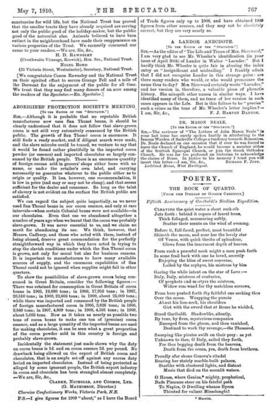ABORIGINES' PROTECTION SOCIETY'S MEETING .
[To THE EDITOR OP THE "SPECTATOR."] SIR,—Although it is probable that no reputable British manufacturer now uses San Thome beans, it should be clearly understood that it does not follow that slave-grown cocoa is not still very extensively consumed by the British public. The growth of San Thome cocoa is enormous. It still finds a ready market, and if diligent search were made, and the slave microbe could be traced, we venture to say that it would be found rather plentifully in the imported cocoa powder (or essence) and imported chocolates so largely con- sumed by the British people. There is an enormous quantity of foreign cocoas sold in grocers' shops either loose with no name, or under the retailer's own label, and carrying necessarily no guarantee whatever to the public either as to origin or quality. It has, however, one recommendation, it is low in price (and may or may not be cheap), and that seems sufficient for the dealer and consumer. So long as the taint of slavery is not evident on the surface the British public are satisfied.
We can regard the subject quite impartially, as we never used San Thome beams in our cocoa essence, and only at rare intervals—when certain Colonial beans were not available—in our chocolates. Even that use we abandoned altogether a number of years ago when we learnt that the cocoa was probably slave-grown. It was never essential to us, and we claim no merit for abandoning its use. We think, however, that Messrs. Cadbury, and those who acted with them, instead of being abused, deserve great commendation for the perfectly straightforward way in which they have acted in trying to stop the slavish conditions under which the San Thome cocoa is grown, not only for moral but also for business reasons. It is important to manufacturers to have many available sources of supply, and the enormous capabilities of San Thome could not be ignored when supplies might fail in other quarters.
To show the possibilities of slave-grown cocoa being con- sumed in Great Britain, consider the following figures :— There was retained for consumption in Great Britain of cocoa beans in 1905, 19,880 tons ; in 1906, 17,958 tons ; in 1907, 20,516 tons; in 1908, 23,606 tons; in 1909, about 25,000 tons ; while there was imported and consumed by the British people of foreign manufactured cocoa in 1905, 3,826 tons; in 1906, 3,840 tons ; in 1907, 4,809 tons ; in 1908, 4,595 tons ; in 1909, about 5,050 tons. Now as it takes as nearly as possible two tons of cocoa beans to make one ton of (genuine) cocoa essence, and as a large quantity of the imported beans are used for making chocolates, it can be seen what a. great proportion of the cocoa powder sold in this country is foreign and probably slave-grown.
Incidentally the statement just made shows why the duty on cocoa beans is ld. and on cocoa essence 2d. per pound. No drawback being allowed on the export of British cocoa and chocolates, that is an ample set-off against any excess duty levied on imported chocolates. Instead of being protected as alleged by some ignorant people, the British export industry in cocoa and chocolate has been strangled almost completely. "–We are, Sir, &c., CLARKE, NICHOLLS, AND COOMBS, LTD. (G. MATHIESON, Director.) Clarnito amfectionery Works, Victoria Park, N.E.
P.S.—I give figures for 1909 "about," as I hare the Board of Trade figures only up to 1908, and have obtained 1909 figures from other sources, and they may not be absolutely correct, but they are very nearly so.










































 Previous page
Previous page